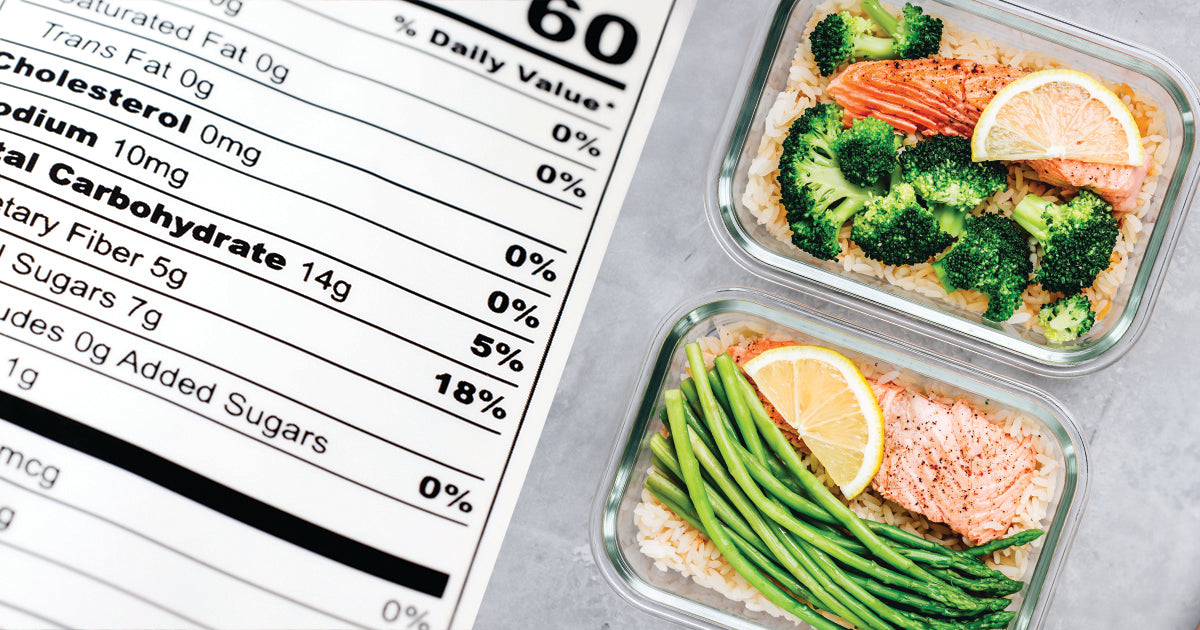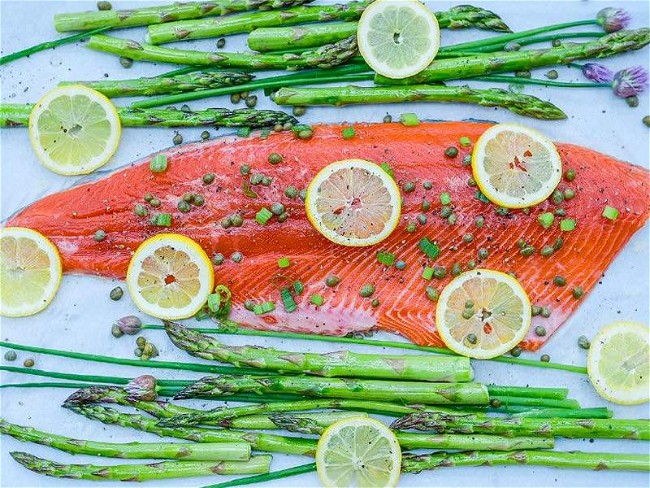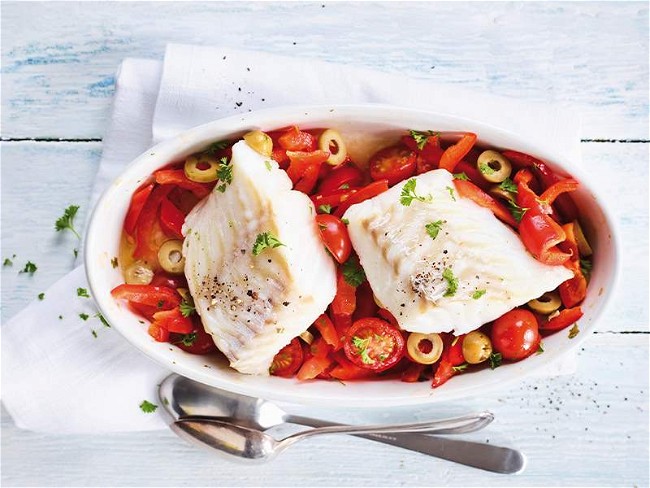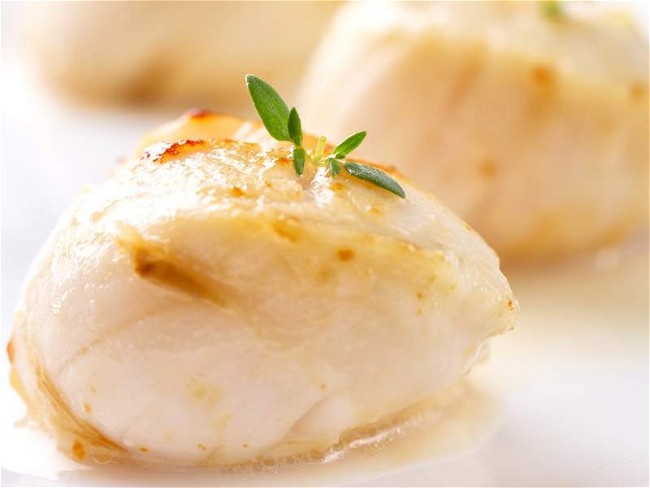Health Benefits of Seafood

If you’re eating for longevity and vitality or simply looking to eat healthier, seafood deserves a starring role on your plate. Seafood is unmatched versus other protein sources in its ability to reduce disease risks and provide essential nutrients, which is why the FDA (Food and Drug Administration), USDA (United States Department of Agriculture), and AHA (American Heart Association) advocate eating seafood multiple times per week.
Seafood's omega-3s, lean protein, and numerous vitamins and minerals have served humans since the very origins of our species and are a key element in brain health, heart health, eye health, skin health, and a healthy immune system.
- Seafood Diets
- High Protein
- Low Cholesterol
- Heart Health and Brain Health from Omega-3 Fatty Acids
- Skin Health from Vitamin E
- Low Saturated Fat
Seafood Diets
It's no surprise that seafood appears frequently across today’s most popular diets. Whether the focus is healthy fats, lean protein, reduced red meat consumption, or heart health, seafood can play an integral part in almost any diet. Here are some of the most popular diets and how seafood works into them:
- Mediterranean Diet: Seafood is a hallmark of the heart-healthy Mediterranean Diet, centered around traditional Mediterranean cuisine that often includes squid, branzino, octopus, and more.
- Whole30: All seafood is an approved protein source in the Whole30 diet, with a focus on anti-inflammatory omega-3s and substantial protein to help promote healthy weight management, steady energy levels, and reduce cravings.
- Nordic Diet: Inspired by Scandinavian food traditions, fatty fish varieties like salmon, mackerel, and herring are featured in the Nordic Diet for their abundance of healthy omega-3 fats.
- DASH Diet: Designed to support healthy blood pressure, The DASH (Dietary Approaches to Stop Hypertension) Diet recommends at least 8 oz of seafood and other lean proteins each week.
- Keto Diet: This diet aims to achieve a metabolic state of ketosis by drastically reducing carb intake and increasing healthy fats. Seafood is an ideal protein source for a Keto diet. It helps dieters meet their macronutrient needs with high-quality protein, healthy omega-3 fatty acids, and little to no carbs.
- Atkins Diet: Similar to the Keto Diet, the Atkins Diet focuses on reduced carbohydrate intake while supporting protein and fat. Seafood is a staple across all phases of the Atkins Diet. Its low carb content and rich nutritional profile make it an ideal choice for maintaining ketosis in the early stages and supporting long-term health in later phases.
- Pescatarian Diet: The pescatarian diet is a seafood- and plant-based diet that aims to reduce or eliminate land-based meat consumption. Seafood is a primary source of protein, vitamin B-12, and iron for pescatarians.
- Carnivore Diet: This diet of exclusively animal products allows seafood as a primary protein source. Fish and shellfish round out the diet with nutrients like omega-3 fatty acids, vitamin D, and iodine while aligning with the diet's zero-carb approach.
- Flexitarian Diet: This semi-vegetarian approach to eating encourages mostly plant-based eating while allowing occasional meat and animal products. Seafood is recommended as a sufficient source of protein and vitamin D, which is particularly beneficial for those reducing their dairy intake, as fatty fish can help meet calcium and vitamin D needs.
What are the best fish to eat for your health?
The short answer is that you should find seafood you enjoy eating. When you find seafood you enjoy eating and cooking, it’s easy to eat more! A quick look at the nutrition labels will show you that most seafood is packed with key macronutrients, vitamins, and minerals.
Seafood's nutritional benefits are about as vast as the oceans themselves. We have teamed up with registered dietitian Dr. Kimberly Stran, PhD, RDN at the University of Alabama, to highlight seafood's nutritional benefits, explain why they're so important for our bodies, and share some of our favorite seafood selections for unlocking each key advantage. Keep in mind that these are just some of our favorites. The variety of species that provide these benefits is almost endless. For additional information, you can find the nutrition labels on all of our product pages.
High Protein
There’s no shortage of fish that are high in protein. Protein is essential for building and repairing tissues, making enzymes and hormones, and supporting a healthy immune system. "Fish is an excellent source of protein that limits your saturated fats," Dr. Stran shares. Most seafood choices give you complete protein, similar to beef and chicken, while reducing saturated fats and providing additional nutrients to your body. The recommended daily allowance (RDA) for protein is 0.36g per pound you weigh. For example, if you weigh 100 pounds, your RDA for protein is 36g.
Here are some of our favorite high-protein fish:
- Ahi tuna yields a mighty 26g of protein per 3.5oz serving, making it a top lean protein choice for sushi lovers and grill masters alike.
- Among many other health benefits, octopus delivers 25g of protein in a 3.5oz portion, plus nutrients like vitamin B12.
- Each 3.5oz serving of wild king salmon provides 24g of complete protein to help build muscle.
- Wild blue shrimp boasts 23g of protein per 3.5oz, with minimal fat and calories.
Low Cholesterol
Many species of seafood, particularly fish, are beloved by consumers and dietitians alike for their low cholesterol content. Cholesterol comes in two forms–LDL (low-density lipoprotein) and HDL (high-density lipoprotein). LDL cholesterol is regarded as a “bad” cholesterol, as it tends to accumulate in artery walls. HDL cholesterol is considered “good” cholesterol because it helps remove excess LDL cholesterol from the bloodstream. According to Dr. Stran, eating foods high in unsaturated fats, like many seafoods, can raise your HDL levels and effectively lower your LDL levels. Although dietary guidelines once recommended limiting daily cholesterol to under 300mg, recommendations have since shifted to avoiding saturated fats and simply keeping cholesterol as low as you can. “Fish can definitely be part of a healthy low-cholesterol diet, especially compared to other sources of meat," she shares.
Here are some of our favorite seafoods that won’t leave you cholesterol-conscious:
- Anchovies are great low-cholesterol fish, packing a lot of nutrients and flavor into their tiny fillets, including just 51mg of cholesterol in a 3.5oz serving.
- Black cod has 44mg cholesterol per 3.5oz serving–yet another reason to indulge in the buttery & flavorful luxury from the Pacific Ocean’s depths.
- Each salmon species, especially Atlantic salmon (55mg cholesterol per 3.5oz serving), can not only be enjoyed without cholesterol worries but also help to combat your LDL levels thanks to their excellent sources of omega-3 fatty acids! More on that in omega-3s below.
- Rainbow trout, a close relative of salmon, provide an excellent freshwater source of nutrients while keeping cholesterol at just 59mg per 3.5oz serving.
- Branzino, also called European sea bass, holds only 62mg cholesterol per 3.5oz serving. Branzino is not just versatile but also trusty in its health benefits, making for a hearty and decadent main dish.
Heart Health and Brain Health from Omega-3 Fatty Acids
Omega-3 fatty acids are a type of polyunsaturated (read healthy) fat that provides numerous health benefits to humans, including heart health and brain health. Dr. Stran explains, "Omega-3s lower your triglycerides, a type of fat found in the blood, helping to reduce inflammation in the body and protect blood vessels from heart attacks and strokes.” Omega-3s, however, cannot be produced by the human body. These essential nutrients must be obtained through dietary sources. You may see omega-3 fatty acids labeled as simply omega-3s, omega-3 oils, or even fish oil.
Omega-3s come in three main forms:
- EPA (Eicosapentaenoic Acid): One of the most beneficial omega-3s, EPA promotes heart health by lowering triglycerides, blood pressure, and inflammation. It also supports brain function and development. EPA is found primarily in oily fish like salmon, mackerel, sardines, and anchovies.
- DHA (Docosahexaenoic Acid): This omega-3 fatty acid is vital for brain health from pregnancy through old age. DHA comprises a large structural portion of the brain's gray matter. It also supports eye health. Like EPA, DHA is most abundant in oily fish.
- ALA (Alpha-Linolenic Acid): This omega-3 is essential for human health, but our bodies can only convert a small amount to the more efficient EPA and DHA forms. ALA supports heart health and is most often found in plant-based foods like walnuts, flaxseeds, and avocados.
When looking to add more omega-3s to your diet, look no further than seafood. While you can find traces of these nutrients in land proteins like eggs and grass-fed lamb, oily seafoods are the best foods for omega-3 fatty acids. The National Institutes of Health recommends consuming 1,100-1,600mg of omega-3s per day.
Here are some of the best fish for omega-3 fatty acids:
- Herring (909mg EPA, 1,100mg DHA per 3.5oz serving) has been a dietary staple in Scandinavian cuisines for centuries, sustaining hardy fishing communities with their remarkable omega-3 fatty acid content.
- Mackerel (898mg EPA, 1,400mg DHA per 3.5oz serving) brings heart and brain health to many Mediterranean and Asian culinary traditions.
- Wild king salmon (1,010mg EPA, 944mg DHA per 3.5oz serving) is the largest and richest Pacific salmon species in both EPA and DHA. Determining the healthiest salmon depends on your own health goals, but odds are king salmon will always be a contender thanks to its nutrient density.
- Atlantic salmon (862mg EPA, 1,100mg DHA per 3.5oz serving) is considered the poster child of the omega-3 movement. Synonymous with fish oil, Atlantic salmon is a modern dietary superstar across the Western world thanks to its polyunsaturated fat content and accessibility to consumers.
- Black cod (677mg EPA, 718mg DHA per 3.5oz serving) is not just a low-cholesterol fish but is also one of the best fish for omega-3 fatty acids.
Skin Health from Vitamin E
While omega-3-rich seafood can bring you proven skin benefits, those with vitamin E can even further support glowing skin health. Vitamin E is an antioxidant that can protect cells from free-radical damage, which is harmful damage to your body’s tissue and cells from oxidation. The recommended daily allowance (RDA) for vitamin E is 15mg per day for those 14 years and older. If you’re looking to up your vitamin E intake, land proteins like chicken and duck may not be the breakthrough you need for your breakouts. Instead, try adding these seafoods to your plate to help reach your vitamin E goals:
- Atlantic salmon (3mg vitamin E per 3.5oz serving) is one of the best foods for skin health. Atlantic salmon doubles down on its high omega-3 content with significant vitamin E to help transform your skin with consistent consumption.
- Sardines (3mg per 3.5oz serving) provide substantial vitamin E, even in their most common canned format. Whether you’re lucky enough to enjoy fresh sardines or having a “tinned fish moment,” know you’re doing your skin a delicious favor!
- Blue crab meat (2.2mg per 3.5oz serving) is an excellent source of skin-loving vitamin E, along with many other essential vitamins like A, B12, and C.
- Swordfish (2mg per 3.5oz serving) loads up on antioxidants like vitamin E to fuel its long-distance migrations, making its meat a nutritional powerhouse for glowing skin.
- Rainbow trout (2mg per 3.5oz serving) can help you reach both low cholesterol and skincare goals in one go. Consider this freshwater delight to add some glow to your diet and skin!
Low Saturated Fat
Many Americans struggle to keep their intake of artery-impairing saturated fats in a healthy range. Unlike heart-healthy unsaturated fats like omega-3s, overconsumption of saturated fats like those found in red meat can raise levels of harmful LDL cholesterol and increase risks of heart attack or stroke. To mitigate these risks, Dr. Stran recommends reducing foods high in saturated fat like cheese, butter, and land proteins like steak. “Consider adding fish and other seafood instead," she adds. The Dietary Guidelines for Americans recommendation for saturated fats is under 10% of your total daily calories. So if you consume 2,000 calories per day, it is recommended that you consume under 200g of saturated fat daily.
Fortunately, our oceans provide an abundance of foods low in saturated fat. If watching your saturated fat intake is a priority, consider these low-fat seafoods:
- Scallops (0g saturated fat per 3.5oz serving) are sweet, succulent sea mollusks that give you up to 20g of lean protein without a single gram of saturated fat. The health benefits of scallops only begin at low saturated fat, too. Scallops are high in many essential vitamins and minerals like iron and B12.
- Pacific cod (0g saturated fat per 3.5oz serving) and Atlantic cod (0.1g) both offer exceptional guilt-free versatility. These flaky white fish are often baked, broiled or air-fried for low-fat cooking through and through.
- Yellowfin tuna (0g saturated fat per 3.5oz serving) supplies 25g of protein without any saturated fat. If you’re seeking a tender and saturated fat-free alternative to steak, look no further!
- Squid (0.1g saturated fat per 3.5oz serving) makes for a widely available, low-fat appetizer or entrée protein for your next dinner party.
- Queen crab (0.1g saturated fat per 3.5oz serving) and king crab (0.2g) each make for indulgent bites that don’t bite you back. Well, as long as they’re cooked! These sweet, velvety crustaceans deliver over 20g of protein, numerous additional vitamins and minerals, and oh-so-sweet flavors with little trace of saturated fat.
- Clams (0.2g saturated fat per 3.5oz serving) are crowd pleasers and heart pleasers alike. Steamed, baked, or garnished on your pasta, clams are a reliable source of protein and hold considerably low saturated fat in each serving.
While there is no “one size fits all” fish for a healthy life, opting for seafood at least 2 times per week can improve your health. From reducing disease risks to delivering a powerhouse of essential nutrients, seafood's health benefits are truly unmatched compared to other proteins.
If you're looking to improve your diet, we encourage you to speak with your doctor or registered dietician to receive personalized guidance tailored to your specific needs.
For more information on our seafood’s nutrition, check out the nutrition labels found on each page on our site. For more detailed seafood health resources, please visit the US Department of Agriculture’s FoodData Central.
FAQs
How much seafood should I eat?
The FDA's Dietary Guidelines For Americans recommends adults consume 8 ounces of seafood per week as part of a healthy diet. Pregnant or breastfeeding people are advised to consume between 8 and 12 ounces of lower mercury seafood per week.
Is all seafood healthy?
While seafood tends to offer unrivaled nutritional benefits, it's important to acknowledge that not all seafood is exclusively filled with the best nutrients. Here are some potential health concerns to be aware of and how to mitigate each risk as you eat from the sea:
- Mercury: Certain species of larger fish that sit atop the marine food chain can naturally contain higher levels of mercury due to their diets and habitats. Even though some larger predatory fish like bluefin tuna and marlin may have higher mercury levels, contamination in humans is typically only a concern for high risk populations. If you are pregnant, nursing, or feeding a young child, you can read more from the FDA about safe seafood consumption.
- Microplastics: While research is ongoing, current evidence suggests that the levels of microplastics in seafood are generally low and unlikely to pose significant health risks to most consumers. To minimize exposure, consumers can opt for smaller fish species and shellfish that have been cleaned of their digestive tracts, otherwise known as deveined.
- High Sodium: When it comes to fresh, unprocessed seafood, high sodium is generally a non-issue. According to Dr. Stran, "recommendations are now typically under 2,300mg sodium per day. For people with hypertension it's under 1,500mg sodium per day. We need sodium, but too much can be harmful. People who consume too much sodium are put at risk of stroke and heart disease." Some canned, smoked, cured or salted seafood varieties, however, may contain very high amounts of sodium that may be a concern for salt averse eaters. "Cured and smoked seafood can have a place in your diet,” Dr. Stran explains. “You just want to be conscious of how much you eat." We always recommend checking the nutrition label on your seafood ahead of eating it to ensure it aligns with your sodium and other intake limitations.
Is fried fish healthy?
Even the healthiest fish, or any food for that matter, can quickly become unhealthy if deep fried or prepared with unhealthy ingredients. While frying can degrade some of seafood's natural nutrients, the cooking method makes a difference. Air frying or pan searing in a light cooking oil are smarter alternatives to deep frying when craving crispy fish.
What are healthy ways to cook fish?
To maximize the nutrition you're getting from seafood, opt for healthier preparation methods like steaming, baking, or grilling, or enjoying it raw as sushi or ceviche if safe to do so. These preparation techniques allow the seafood's natural flavors and nutrients to truly shine without the need for excessive oils or batters. If you're craving that crispy fried texture, consider an air fryer as a healthier alternative to deep frying. You can learn more about these techniques from our guide on how to cook fish.
Ready to jump right into healthy eating? Check out these clean recipes to get started:
Sheet Pan Wild Salmon Piccata Recipe
We love easy sheet pan seafood dinners, especially mid-week when there's no time to cook, but you still want something delicious and healthy. Our sheet pan salmon is made with wild salmon and asparagus, the ideal weeknight dinner.
Low carb doesn’t have to be boring with our Baked Cod recipe! Atlantic cod is oven-baked with a delicious combination of peppers, tomatoes, and olives and finished with a sprinkle of fresh parsley. Try this recipe for a quick and easy weeknight meal that’s tasty, healthy, and miles away from boring!
Keto Fish Cakes with Herb Salad Recipe
Swap out breadcrumbs for almond flour, and what do you get? Keto Fish Cakes! Our delicious Keto fish cake recipe uses salmon fillets, eggs, and almond flour. For all the flavor of traditional fish cakes but Keto-friendly! Served with a citrusy herb salad, these are perfect for a weeknight dinner, and you’ll even have some leftovers for lunch.
Air Fryer Scallops with Lemon-Garlic Sauce Recipe
Large and meaty dry sea scallops are perfect for this delicious air fryer recipe! Include the lemony-garlic sauce for some pizzazz.
Is shellfish healthier than finfish?
Both shellfish and finfish offer fantastic options to meet your health goals. While each species is different, here are some general differences between the two categories as you consider your dietary needs:
- Shellfish like shrimp, lobster, and crab tend to be leaner than finfish, yielding very little fat or calories while delivering sufficient protein. Shellfish’s beneficial omega-3 fatty acid content is often lower than finfish, while higher in cholesterol.
- Conversely, finfish like salmon, tuna, and mackerel are often more loaded with heart-healthy omega-3s while keeping cholesterol at bay. Finfish may yield higher calories and sometimes increased saturated fat content versus shellfish.
What factors impact seafood's nutrition?
Beyond general nutritional facts, some other factors may impact the health benefits you receive from seafood. The most impactful variable for your seafood’s nutrition is how you prepare it. Frying fish or adding heavy, calorie-dense sauces can negate many of its health benefits. Grilling, baking, and steaming are recommended preparations that keep seafood’s nutritional integrity. Opting for simple, healthy preparation methods ensures you maximize the nutritional benefits of your seafood while minimizing added fats and calories.
Harvesting methods also play a part in seafood’s nutrition. Wild, frozen seafood should be frozen quickly at peak freshness to lock in maximum nutritional quality. Conversely, improperly frozen seafood can deteriorate and lose nutrients over time. Farm-raised seafood’s diet, living conditions, and harvesting practices are critical to the health of each animal and their environment. Contaminated water, overcrowding, and/or irresponsible farming can negatively impact the seafood's nutritional value.
Sustainability matters for the health of our meals, food systems, and most importantly our oceans. Sourcing from well-managed fisheries and trusted farms ensures maximal health benefits to ourselves and our ecosystems for generations to come. At Fulton Fish Market, our quality assurance and responsible sourcing account for these factors. We ensure you receive the highest quality, most nutrient-dense seafood while promoting sound environmental practices.
What is the healthiest type of salmon?
While “healthiest” is subjective, and all salmon deliver an excellent source of omega-3s, protein, and nutrients, king salmon and Atlantic salmon are often coveted for their health benefits. Their larger sizes and high unsaturated fat content mean higher concentrations of omega-3s like EPA and DHA per portion. This does not take away from sockeye or other salmon species, which have remarkable health benefits of their own.
Is frozen fish healthy?
Yes! Frozen fish that is blast frozen at peak freshness can retain its full nutritional value over long periods of time when properly stored.
Is canned fish healthy?
Canned fish can absolutely be part of a healthy diet and offers a convenient way to boost your seafood intake. However, be mindful of the various preservation techniques for canned seafood. For example, one can of seafood may contain under 5% of your recommended daily sodium per serving, while another brand or species may be canned with over 100% of your daily sodium.
Is omega-3 the same as fish oil?
Not exactly. Omega-3s are a group of nutrients that are often found in oily fish, while fish oil usually represents supplements with omega-3 fatty acids as their active nutrients. These fish oil supplements are typically formulas with high concentrations of omega-3s derived from oily fish like anchovies or mackerel.
What is omega-6?
Omega-6 fatty acids are another type of polyunsaturated fat that play a crucial role in human health. While often overshadowed by omega-3s, omega-6s are equally essential and must be obtained through diet. Omega-6s are vital for brain development, skin health, and regulating metabolism, which is why The American Health Association recommends replacing trans fats and saturated fats with omega-6 fatty acids. While omega-6s are beneficial, it is recommended that you consume more omega-3s than omega-6s.
Is farm-raised fish healthy?
Farm-raised fish can absolutely be a healthy choice, generally offering similar nutritional benefits to their wild-caught counterparts. However, not all aquaculture practices are equally healthy. Responsible farming methods focused on proper feed, living conditions, minimizing antibiotic use, and environmental sustainability are ideal to ensure both the fish and you receive maximum benefits.
Meat vs. Seafood
Is seafood healthier than meat?
Both seafood and meat offer unique nutritional benefits. Generally speaking, seafood is rich in omega-3 fatty acids, iodine, and selenium while typically being lower in saturated fat. Meat generally provides substantial protein, vitamin B12, iron, and zinc. Ultimately, both seafood and meat can be excellent protein sources when part of a balanced diet. The key is variety and moderation. Incorporating a mix of seafood and lean meats ensures a wide range of essential nutrients.




